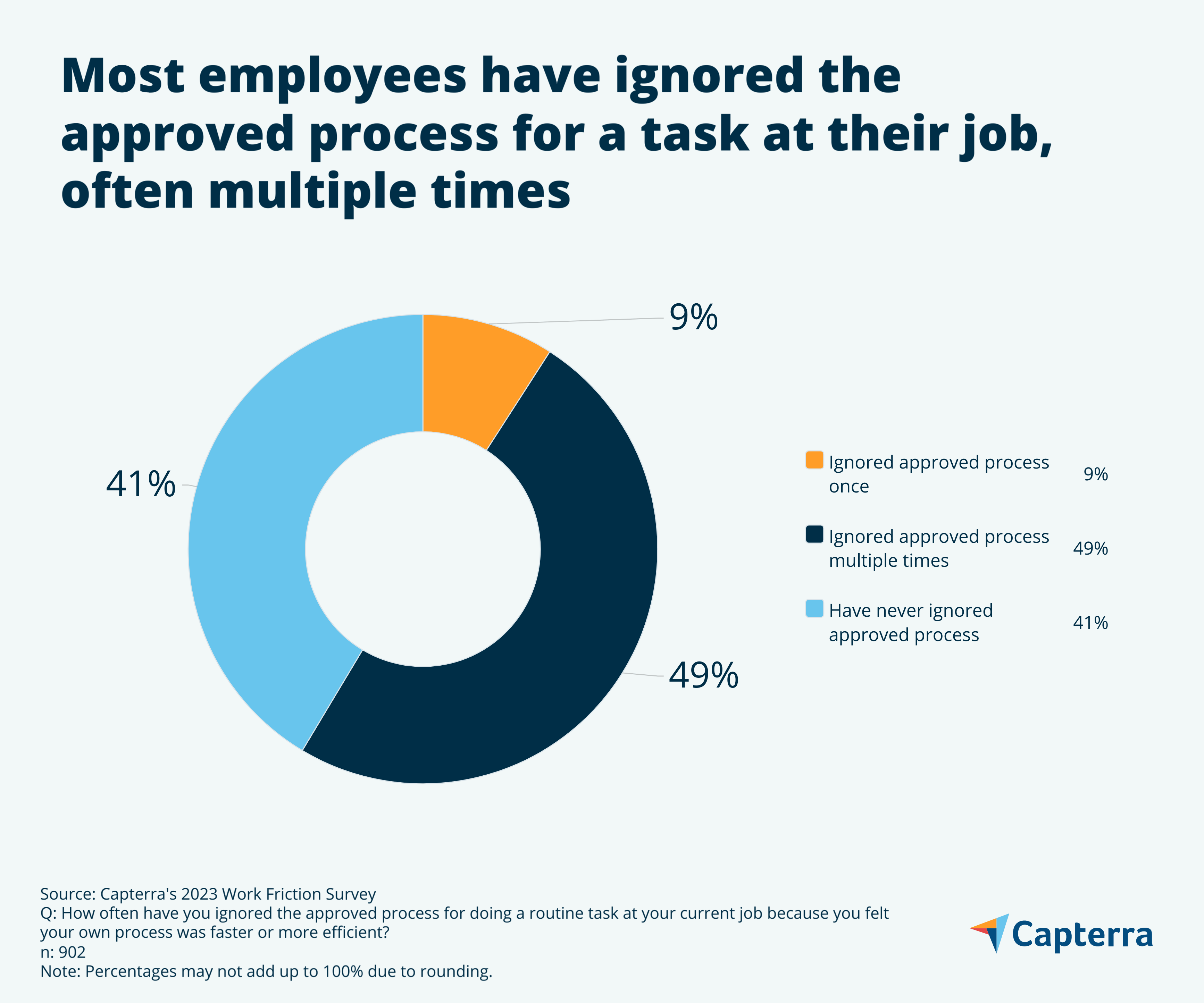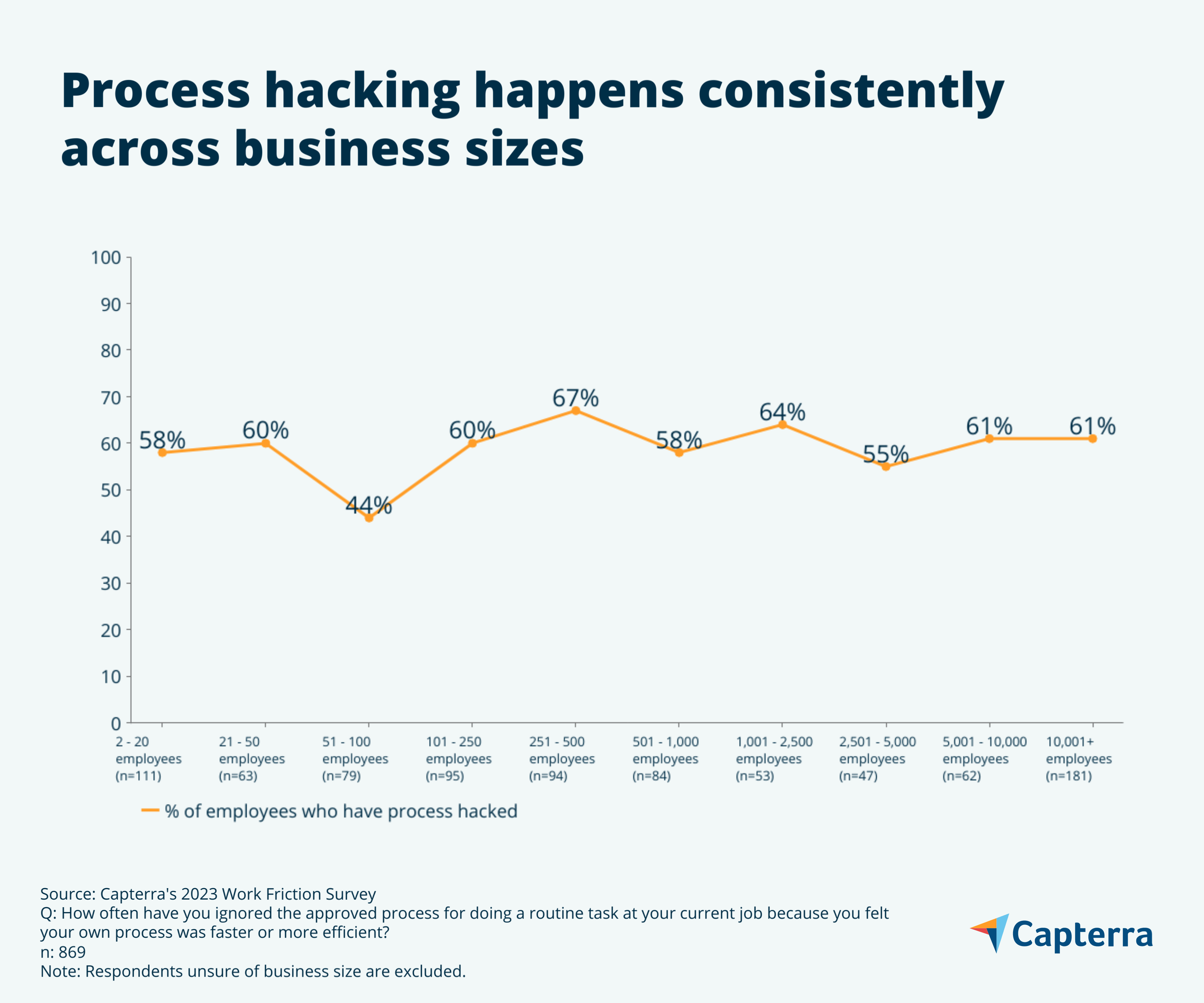Employees say they’re hacking their own job processes to be faster or more efficient. HR needs to reduce work friction to eliminate these potentially dangerous workarounds.
As HR departments strive to cultivate a more agile and responsive workforce, a significant obstacle stands in their way: work friction. A symptom of misaligned work design and inefficient processes, Gartner found that employees who have to work around friction spend an average of 1.9 additional hours per day on routine tasks, which adds up to almost 70,000 wasted hours per year at a 100-person company.[1]
Wait, what’s work friction?
Work friction defines any wasted effort with a job process. If you’ve ever felt that doing something at your job had unnecessary steps or took longer than it should, you’ve run into work friction.
The time wasted by work friction is damaging enough. But a Capterra survey of over 900 employees* finds that in order to avoid work friction, a majority of workers are going rogue and stealthily hacking together their own job processes—putting organizations at serious risk.
In our survey, 59% of employees say they have ignored the approved process for a routine task at their job because they felt their own process was faster or more efficient. Of those who have hacked their own work process, 55% say their employer never found out about it.
In this report, we’ll dive into our survey results to reveal which employees hack work processes most often, and detail how HR leaders can redesign processes to reduce work friction and enable greater workforce agility.
/ Key findings
Most employees are guilty of process hacking: 59% of workers have ignored the approved process for a routine task because they felt their own process was faster or more efficient, and 49% have done so multiple times.
Tenured employees, marketing departments process hack the most: Employees who've been at a company for 10+ years are 42% more likely to have hacked their work processes than those who've been at a company less than six months. Marketing (71%) and production (70%) are the departments most likely to have hacked work processes.
Frequent process reviews can reduce process hacking: When employees strongly agree that work processes are reviewed frequently to ensure they're up-to-date, they are 45% less likely to process hack.**
Your employees are probably ignoring company processes
In topsy-turvy times, companies recognize the importance of an agile and responsive workforce. Not only do responsive employees react better to unexpected adversity, but they are at least 20% more likely to overperform against key goals.[1]
Employees want to be agile, too. Unfortunately, work friction caused by unnecessary red tape, confusing processes, and janky systems often gets in the way—in everything from requesting PTO to operating a forklift.
And when employees run into too much work friction that hampers their ability to be responsive, they aren’t going to grin and bear it. Instead, our survey shows that they’ll ignore the approved process and figure out their own. Not only is this “process hacking” commonplace, but you probably don’t even know it’s happening. Of those who have hacked together their own work process, 55% say their employer never found out about it.

Process hacking happens across businesses large and small
Diving deeper into our data, we find that some employees process hack more than others.
Tenured employees process hack more than new hires
Employees who've been at the same company for 10+ years are 42% more likely to have hacked their work process than those who've been at a company less than six months. This indicates that when employees feel they’ve learned the ropes of company policies and processes, they are more comfortable going outside of those defined boundaries.
Marketing and production are the top process hacking departments
Seventy-one percent of marketing employees and 70% of production employees say they have hacked processes on the job—giving insight into the wide range of risk outcomes facing companies due to process hacking.
At best, a marketer in your organization may have found a more efficient way to do a certain task, and is hoarding it for themselves. At worst, someone on your production line could be side-stepping important legal, safety, or product tolerance guidelines to do their job faster.
There is no correlation between business size and process hacking
Critically, we find that process hacking is not a “big company” or “small company” problem. In our survey, workers at companies with two to 20 employees (58%) were just as likely to hack their own processes as workers at companies with more than 10,000 employees (61%).

These results show that having more entrenched or refined processes as a big business doesn’t stop process hacking, and neither does throwing more bodies at process management.
Whether you’re an HR department of one or many, the issue is the same: work design.
5 ways HR departments can reduce work friction and foster a responsive culture
Modern work design is rife with inefficiencies and points of friction that hamper responsiveness. At the same time, processes exist for a reason. Even steps that seem frivolous on the surface are often critical to ensuring consistency and minimizing risk.
To reduce work friction and process hacking, HR departments must strike a careful balance between giving employees the flexibility to be more agile and maintaining important safeguards. Here are five ways your department can make it happen.
1. Intervene in new process creation early
/ The supporting stat
When employees “strongly agree” that they often have to create their own work processes because none currently exist, they are 89% more likely to hack their own work process.**
Especially at smaller companies, there’s a tendency to let new hires craft processes on their own. If you don’t have an IT department, it’s highly unlikely you have many formal IT processes when you hire your first IT manager, for example. It makes sense to leave it up to them.
But this thinking can be dangerous. Not only does it encourage process hacking, but when left too much to their own devices, new employees or departments may create processes that don’t align with company messaging or interdepartmental requirements.
Instead of being hands-off, your HR department should proactively identify places where new processes have recently been created or need to be created soon. As these processes are identified, you can work with department leaders to ensure they achieve the desired outcome while still operating within organizational guidelines.
2. Update company processes frequently
/ The supporting stat
When employees "strongly agree" that work processes at their job are reviewed frequently to ensure they're up-to-date, they are 45% less likely to hack their own work process.**
This one is simple but easy to overlook. If employees find that the approved process for a certain routine task doesn’t align with the tools, people, and expectations currently associated with that task, they’re going to start hacking their own.
Doing process audits at least twice a year, with help from end-users of that process to identify gaping holes, can help ensure that they’re as efficient and up-to-date as possible.
3. Make it easy to find decision-makers
/ The supporting stat
When employees "strongly agree" that it’s easy to find the right people to get answers and approve decisions at their job, they are 32% less likely to hack their own work process.**
As companies grow and become more interdepartmentally connected, it becomes more and more difficult for employees to know who the point person is for each process. If employees can’t get answers or decisions quickly, process hacking is inevitable.
A company intranet or even a collaboration app can do wonders here. Your department can create separate channels or pages in these tools for different processes with a clear indicator of the person in charge of that process. Employees then only need to search for the process and they’ll find the person they need. Through many of these tools, workers can then contact that person directly.
4. Move resource decisions closer to the end user
/ The supporting stat
When employees "strongly agree" that they have easy access to tools and resources (including budget) to be able to do their job as expected, they are 43% less likely to hack their own work process.**
Keeping resources like budget close to the top of the org provides important oversight and stability, but it also prevents resources from flowing quickly when and where they’re needed most—hindering workers’ ability to be responsive.
Employees must demonstrate that they’re responsible with these resources, but wherever possible, you should allocate resources closer to the end user. With clearly defined limits and use cases for these resources in place, employees can be much more agile.
For example, if you have employees out in the field who regularly need to re-up supplies or replace broken equipment, letting them do so as needed without going through a formal requisition process every time can be a major time-saver and customer experience booster.
5. Default to “go” instead of “no”
/ The supporting stat
When employees "strongly agree" that their employer is quick to respond to unexpected challenges, they are 37% less likely to hack their own work process.**
In an ideal world, company processes would account for every possible scenario you throw at them. But the way we work is constantly changing, and no matter how hard HR departments try, processes can’t always keep up when deviations are needed.
Exceptions to standardized processes are increasingly prevalent, and when these exceptions arise, companies need to default to “go” instead of “no.”
Instead of creating rigid processes that define how employees should proceed, you should strive to create flexible processes that better define how employees should not proceed. This way workers can feel empowered to deviate as needed to be responsive without keeping it quiet from company leaders or going so far out of bounds that it creates unnecessary risk.
Having responsive talent is only half of a solution
In this case, the people are the easy part. HR departments are already very good at hiring and developing agile workforces. Until you solve for work friction, however, employees who are willing and able to be responsive will either be slowed down through official processes or incentivized to hack their own.
By getting involved in process creation early, resourcing for mobility instead of stability, and formalizing how employees can flex as new situations arise, you can eliminate significant points of work friction and unlock workforce responsiveness.
Did you like this report? Check out some of our other HR content here:
